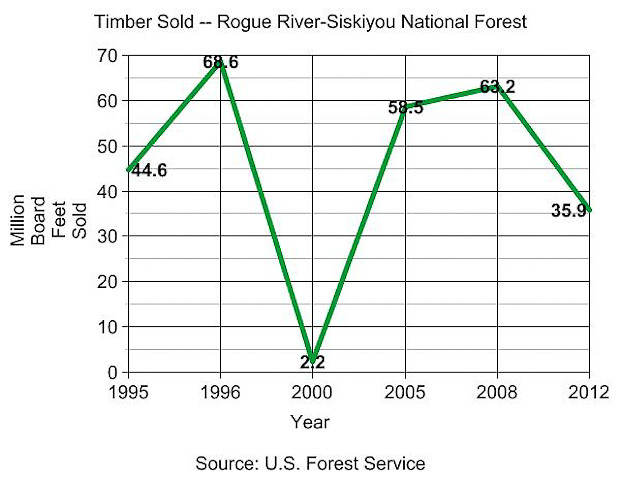
Travis Griess stacks lumber at the Rough and Ready mill, a day after it announced its shut down and laid off most of its workers.
Amelia Templeton
CAVE JUNCTION, Ore. -- This week's news that Rough and Ready Lumber is closing its Cave Junction sawmill is both shocking and familiar to the families in this small town.
As painful as it is for the town's wage-earners and merchants, it's a story they've seen play out in timber towns dozens of times. Of the 390 Oregon mills operating in 1980, three-quarters have since shut down.
“Mills closing down isn’t anything new. I’ve experienced it three times with my father growing up,” says Mariah Carter, an employee at Taylor’s Country Store.
Carter remembers living in a tent in the park after her father lost his job at International Paper in North Bend, Ore. years ago. Today Carter’s fiancé, Travis Griess, stacks and sorts lumber on a planer line at the Rough and Ready mill.
Griess learned his last day will be May 22, a few weeks before their wedding.
“God has a plan. It's too many people losing their jobs all at one time for God not to have a plan," Carter says.”
Many of the mill’s workers were laid off on Wednesday, but a small crew will remain through May to process the last of the lumber.
Lacey Davis, whose husband Mathew was laid of Thursday, says the loss of 85 jobs is going to have a profound impact in this small community.
“They are one of the only companies in this valley that offers benefits for its employees. And that’s huge for our family,” she says.
Credit: Bonnie Stewart
Davis is two months pregnant and expects she and her husband will lose their health care at the end of the month. But she’s optimistic about the future, and says Mathew will receive financial aid to return to school through a displaced worker program.
Both women say they are grateful Rough and Ready's owners managed to keep the mill open through the Great Recession.
Rough and Ready Lumber ran the last operating dimensional lumber sawmill in Josephine and Jackson counties, although several local mills produce plywood and other wood products.
The mill's owners, Jennifer and Link Phillippi, say they decided to shut down because of the difficulty of acquiring logs through federal timber sales, and in spite of rising lumber prices and signs of recovery in the housing market.
“We could sell every stick we can make, and we're sitting in a forest that grows a billion board feet a year. For it to not be able to support just one small sawmill in two counties is just senseless in my mind," Jennifer Phillippi says.”
Lumber stacked in the yard. Photo: Amelia Templeton
The mill has been running at half capacity for ten years. Phillippi says that in order to remain competitive as the housing market perks up, Rough and Ready would need to add a second shift and make about $2 million in capital investments, moves that are too risky given the uncertain supply of timber.
Rough and Ready is surrounded by the Rogue River Siskiyou National Forest and the BLM’s O&C timberlands. Phillippi has been a prominent advocate for logging increases on Oregon’s federal lands and has served on the Oregon Board of Forestry and Governor Kitzhaber’s O&C Lands Commission.
Credit: Bonnie Stewart
“It’s like being a store that’s open only three days a week. We have all these fixed costs, and if we don’t have enough sales to spread those costs against, there’s no margin” she says.
Phillippi says a bipartisan bill introduced in the House by Democrats Peter DeFazio and Kurt Schrader and Republican Greg Walden to create a timber trust from Oregon’s O&C lands would provide a stable supply of lumber that could keep the mill open. But she’s doesn’t expect the trust approach to gain support from Oregon Senator Ron Wyden, who chairs the Powerful Senate Natural Resources Committee.
“I see on the Senate side reduced county payments and thinning and stand-alone wilderness, and that just doesn’t address the jobs issue,” Jennifer Phillippi says.
Critics in the environmental movement attribute Rough and Ready’s struggle to its dependence on older, larger logs. In 2004, the group Oregon Wild called the mill a threat to the state’s old forests.
The Rough and Ready mill produces high-end industrial-grade lumber for windows and doors, and uses on average 80- to 100-year old logs.
“If the business model requires the conservation policies of the last 20 years to be rolled back, that's going to be controversial and it's going to be hard to keep that mill open," says Steve Pedery, conservation director for Oregon Wild.”
Rough and Ready’s owners also manage the Perpetua Forest Company, which owns private timberland.
“Why isn’t there a market on private lands to produce that wood? Why does the burden rely entirely on public lands to provide these older larger trees?” he asks.
Phillippi says the mill couldn’t survive on logs from private land when so much of the land in Southern Oregon is publicly owned: roughly 60 percent of Jackson, Josephine, and Curry county is federal forest. She says contrary to the way the mill has been portrayed by the environmentalists, several of its most successful recent sales were forest health projects in Northern California.







